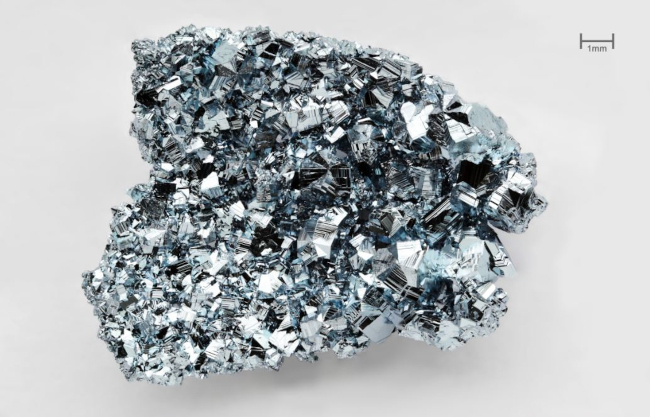
Osmium (Os) is a chemical element of the periodic table, located in the group 8 and the period 6, and is having the atomic number 76. It is a hard, rare, brittle, lustrous, bluish-white transition metal, whose name comes from the Greek word “osme”, which means smell.
On periodic table
| group | ⇨ | 1 | 2 | 3 | 4 | 5 | 6 | 7 | 8 | 9 | 10 | 11 | 12 | 13 | 14 | 15 | 16 | 17 | 18 |
| period | ⇩ | ||||||||||||||||||
| 1 | 1 H  Hydrogen |
2 He  Helium |
|||||||||||||||||
| 2 | 3 Li  Lithium |
4 Be  Beryllium |
5 B  Boron |
6 C  Carbon |
7 N  Nitrogen |
8 O  Oxygen |
9 F  Fluorine |
10 Ne  Neon |
|||||||||||
| 3 | 11 Na  Sodium |
12 Mg  Magnesium |
13 Al  Aluminium |
14 Si Silicon |
15 P  Phosphorus |
16 S  Sulfur |
17 Cl  Chlorine |
18 Ar  Argon |
|||||||||||
| 4 | 19 K  Potassium |
20 Ca  Calcium |
21 Sc  Scandium |
22 Ti  Titanium |
23 V  Vanadium |
24 Cr  Chromium |
25 Mn  Manganese |
26 Fe  Iron |
27 Co  Cobalt |
28 Ni  Nickel |
29 Cu  Copper |
30 Zn  Zinc |
31 Ga  Gallium |
32 Ge  Germanium |
33 As  Arsenic |
34 Se  Selenium |
35 Br  Bromine |
36 Kr  Krypton |
|
| 5 | 37 Rb  Rubidium |
38 Sr  Strontium |
39 Y  Yttrium |
40 Zr  Zirconium |
41 Nb  Niobium |
42 Mo  Molybdenum |
43 Tc  Technetium |
44 Ru  Ruthenium |
45 Rh  Rhodium |
46 Pd  Palladium |
47 Ag  Silver |
48 Cd  Cadmium |
49 In  Indium |
50 Sn  Tin |
51 Sb  Antimony |
52 Te  Tellurium |
53 I  Iodine |
54 Xe  Xenon |
|
| 6 | 55 Cs  Caesium |
56 Ba  Barium |
72 Hf  Hafnium |
73 Ta  Tantalum |
74 W  Tungsten |
75 Re  Rhenium |
76 Os Osmium |
77 Ir  Iridium |
78 Pt  Platinum |
79 Au  Gold |
80 Hg  Mercury |
81 Tl  Thallium |
82 Pb  Lead |
83 Bi  Bismuth |
84 Po  Polonium |
85 At  Astatine |
86 Rn  Radon |
||
| 7 | 87 Fr  Francium |
88 Ra  Radium |
104 Rf  Rutherfordium |
105 Db  Dubnium |
106 Sg  Seaborgium |
107 Bh  Bohrium |
108 Hs  Hassium |
109 Mt  Meitnerium |
110 Ds  Darmstadtium |
111 Rg  Roentgenium |
112 Cn  Copernicium |
113 Nh  Nihonium |
114 Fl  Flerovium |
115 Mc  Moscovium |
116 Lv  Livermorium |
117 Ts  Tennessine |
118 Og  Oganesson |
||
| 57 La  Lanthanum |
58 Ce  Cerium |
59 Pr  Praseodymium |
60 Nd  Neodymium |
61 Pm  Promethium |
62 Sm  Samarium |
63 Eu  Europium |
64 Gd  Gadolinium |
65 Tb  Terbium |
66 Dy  Dysprosium |
67 Ho  Holmium |
68 Er  Erbium |
69 Tm  Thulium |
70 Yb  Ytterbium |
71 Lu  Lutetium |
|||||
| 89 Ac  Actinium |
90 Th  Thorium |
91 Pa  Protactinium |
92 U  Uranium |
93 Np  Neptunium |
94 Pu  Plutonium |
95 Am  Americium |
96 Cm  Curium |
97 Bk  Berkelium |
98 Cf  Californium |
99 Es  Einsteinium |
100 Fm  Fermium |
101 Md  Mendelevium |
102 No  Nobelium |
103 Lr  Lawrencium |
|||||
| – d block |
Osmium is a d-block element, situated in the eighth column and the sixth row of the periodic table, denoted by the atomic number 76 and chemical symbol Os.
Element information
 |
|
 |
|
| Origin of name | Greek word “osme” (which means smell) |
| Symbol | Os |
| Atomic number (Z) | 76 |
| Atomic mass | 190.23 u |
| Block | d-block |
| Group | 8 |
| Period | 6 |
| Classification | Transition metal |
| Atomic radius | 135 pm |
| Covalent radius | 144±4 pm |
| Melting point | 3033 ℃, 5491 ℉, 3306 K |
| Boiling point | 5012 ℃, 9054 ℉, 5285 K |
| Electron configuration | [Xe] 4f14 5d6 6s2 |
| Learn how to write: Osmium electron configuration | |
| Electrons per shell | 2, 8, 18, 32, 14, 2 |
| Crystal structure | Hexagonal close-packed (hcp) |
| Phase at r.t | Solid |
| Density near r.t | 22.59 g/cm3 |
| Main isotopes | Osmium-187, Osmium-188, Osmium-189, Osmium-190, Osmium-192 |
| Natural occurrence | Primordial |
| Oxidation state | +4 |
| Electronegativity (Pauling scale) | 2.2 |
| Protons Neutrons Electrons |
76 114 76 |
| Learn how to find: Osmium protons neutrons electrons | |
| CAS number | 7440-04-2 |
| Discovered by | Smithson Tennant in 1803 |
History

Osmium was discovered in 1803 by English chemist Smithson Tennant. Tennant was examining the residues left after dissolving platinum in nitrohydrochloric acid and discovered a black residue that resisted attack by acids and alkalis. He identified this substance as a new element, which he named “osmium” after the Greek word “osme,” meaning “smell,” because of the strong smell of the volatile osmium tetroxide compound produced when osmium is heated.
However, it was not until the mid-1800s that the properties of osmium were more fully investigated. In 1844, Swedish chemist Carl Gustaf Mosander succeeded in separating osmium from other platinum metals, and in 1860, English chemist Thomas Andrews was the first to determine the density of osmium, which is the densest naturally occurring element. Since its discovery, osmium has been found in platinum ores and also in river sands in the Urals and North America.
Occurrence and production
Osmium is a rare and highly dense metal that occurs naturally in the Earth’s crust. It is one of the least abundant elements in the Earth’s crust and is usually found as a trace element in ores of other metals such as nickel, copper, and platinum. The largest producers of osmium are Russia, Canada, and South Africa.
Osmium is typically produced as a byproduct of nickel or copper refining, with most of the world’s osmium coming from nickel mines in the Sudbury Basin in Canada and the Norilsk region in Russia. The metal is extracted from the residues of the refining process by dissolving it in sodium peroxide, which converts the osmium to the more soluble osmium tetroxide. The osmium tetroxide can then be reduced with hydrogen gas to produce pure osmium metal.
Properties
Osmium is a hard, brittle, dense, silvery-white transition metal that is part of the platinum group metals.
It has a high melting point of 3033 ℃ and a boiling point of 5012 ℃, which are the highest of all the elements.
Osmium is also extremely dense, with a density of 22.59 g/cm3, making it the densest naturally occurring element.
It has a very low electrical resistance and is a good conductor of heat and electricity.
Osmium is also highly resistant to corrosion, making it useful in various applications, including as an alloying agent with other metals to improve their hardness and resistance to wear.
Osmium also has a very high refractive index, making it useful in optical applications such as in the production of pen tips and phonograph needles.
Osmium is known for its blue-gray tint, which is used in fountain pen inks, and for its toxicity, which has limited its use in certain applications such as jewelry making.
Applications
Alloys
Osmium is often used as an alloying agent with other metals to increase their hardness, corrosion resistance, and other properties. For example, it is added to platinum to make an alloy that is used in the production of fountain pen nibs, electrical contacts, and other high-wear applications.
Catalysts
Osmium compounds are used as catalysts in a variety of chemical reactions, such as asymmetric dihydroxylation of alkenes and the conversion of alkenes to aldehydes or ketones.
Electronics
Osmium is used in some electronic applications, such as in the production of thin-film resistors and in the manufacture of electrical contacts.
Medicine
Osmium compounds have shown promise in the treatment of cancer and other diseases. For example, osmium tetroxide is used in microscopy as a stain for biological tissues, and osmium-based compounds have been developed as potential anticancer agents.
Jewelry
Osmium is one of the densest elements and has a bluish-gray color, making it a popular choice for jewelry. However, due to its rarity and difficulty in processing, osmium jewelry is quite expensive.
Interesting facts
Osmium is the densest naturally occurring element, with a density of 22.59 g/cm3.
It has a blue-gray tint and is brittle at room temperature, but becomes ductile when it is slightly heated.
Osmium is one of the rarest elements on Earth, with only about 50 tons mined each year, primarily from South Africa, Russia, and Canada.
Osmium is also one of the most toxic elements known, and its tetroxide compound is particularly dangerous, as it can cause severe eye and lung damage or even death.
Despite its toxicity, osmium has found some niche applications, such as in the manufacturing of fountain pen tips, phonograph needles, and electrical contacts, as well as in some medical procedures.
Osmium is also used in some alloys, such as osmiridium, which is a hard and durable material used in some high-end watches and jewelry.
Related
More elements
External links
- https://en.wikipedia.org/wiki/Osmium
- https://www.rsc.org/periodic-table/element/76/osmium
- https://www.britannica.com/science/osmium
- https://pubchem.ncbi.nlm.nih.gov/compound/Osmium
- https://www.sciencedirect.com/topics/earth-and-planetary-sciences/osmium
- https://www.chemicool.com/elements/osmium.html
- https://education.jlab.org/itselemental/ele076.html
- https://www.thoughtco.com/osmium-facts-606570
Deep
Learnool.com was founded by Deep Rana, who is a mechanical engineer by profession and a blogger by passion. He has a good conceptual knowledge on different educational topics and he provides the same on this website. He loves to learn something new everyday and believes that the best utilization of free time is developing a new skill.
